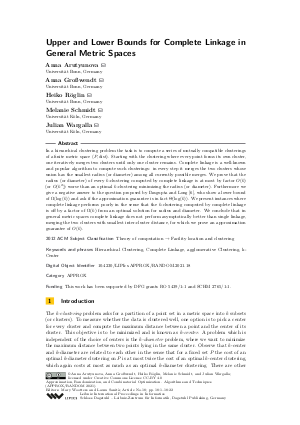Upper and Lower Bounds for Complete Linkage in General Metric Spaces
Authors Anna Arutyunova, Anna Großwendt, Heiko Röglin, Melanie Schmidt, Julian Wargalla
-
Part of:
Volume:
Approximation, Randomization, and Combinatorial Optimization. Algorithms and Techniques (APPROX/RANDOM 2021)
Part of: Series: Leibniz International Proceedings in Informatics (LIPIcs)
Part of: Conference: International Conference on Randomization and Computation (RANDOM)
Part of: Conference: International Conference on Approximation Algorithms for Combinatorial Optimization Problems (APPROX) - License:
 Creative Commons Attribution 4.0 International license
Creative Commons Attribution 4.0 International license
- Publication Date: 2021-09-15
File

PDF
LIPIcs.APPROX-RANDOM.2021.18.pdf
- Filesize: 0.69 MB
- 22 pages
Document Identifiers
Subject Classification
ACM Subject Classification
- Theory of computation → Facility location and clustering
Keywords
- Hierarchical Clustering
- Complete Linkage
- agglomerative Clustering
- k-Center
Metrics
- Access Statistics
-
Total Accesses (updated on a weekly basis)
0Document
0Metadata
Abstract
In a hierarchical clustering problem the task is to compute a series of mutually compatible clusterings of a finite metric space (P,dist). Starting with the clustering where every point forms its own cluster, one iteratively merges two clusters until only one cluster remains. Complete linkage is a well-known and popular algorithm to compute such clusterings: in every step it merges the two clusters whose union has the smallest radius (or diameter) among all currently possible merges. We prove that the radius (or diameter) of every k-clustering computed by complete linkage is at most by factor O(k) (or O(k²)) worse than an optimal k-clustering minimizing the radius (or diameter). Furthermore we give a negative answer to the question proposed by Dasgupta and Long [Sanjoy Dasgupta and Philip M. Long, 2005], who show a lower bound of Ω(log(k)) and ask if the approximation guarantee is in fact Θ(log(k)). We present instances where complete linkage performs poorly in the sense that the k-clustering computed by complete linkage is off by a factor of Ω(k) from an optimal solution for radius and diameter. We conclude that in general metric spaces complete linkage does not perform asymptotically better than single linkage, merging the two clusters with smallest inter-cluster distance, for which we prove an approximation guarantee of O(k).
Cite As Get BibTex
Anna Arutyunova, Anna Großwendt, Heiko Röglin, Melanie Schmidt, and Julian Wargalla. Upper and Lower Bounds for Complete Linkage in General Metric Spaces. In Approximation, Randomization, and Combinatorial Optimization. Algorithms and Techniques (APPROX/RANDOM 2021). Leibniz International Proceedings in Informatics (LIPIcs), Volume 207, pp. 18:1-18:22, Schloss Dagstuhl – Leibniz-Zentrum für Informatik (2021)
https://doi.org/10.4230/LIPIcs.APPROX/RANDOM.2021.18
BibTex
@InProceedings{arutyunova_et_al:LIPIcs.APPROX/RANDOM.2021.18,
author = {Arutyunova, Anna and Gro{\ss}wendt, Anna and R\"{o}glin, Heiko and Schmidt, Melanie and Wargalla, Julian},
title = {{Upper and Lower Bounds for Complete Linkage in General Metric Spaces}},
booktitle = {Approximation, Randomization, and Combinatorial Optimization. Algorithms and Techniques (APPROX/RANDOM 2021)},
pages = {18:1--18:22},
series = {Leibniz International Proceedings in Informatics (LIPIcs)},
ISBN = {978-3-95977-207-5},
ISSN = {1868-8969},
year = {2021},
volume = {207},
editor = {Wootters, Mary and Sanit\`{a}, Laura},
publisher = {Schloss Dagstuhl -- Leibniz-Zentrum f{\"u}r Informatik},
address = {Dagstuhl, Germany},
URL = {https://drops.dagstuhl.de/entities/document/10.4230/LIPIcs.APPROX/RANDOM.2021.18},
URN = {urn:nbn:de:0030-drops-147115},
doi = {10.4230/LIPIcs.APPROX/RANDOM.2021.18},
annote = {Keywords: Hierarchical Clustering, Complete Linkage, agglomerative Clustering, k-Center}
}
Author Details
Funding
This work has been supported by DFG grants RO 5439/1-1 and SCHM 2765/1-1.
References
- Marcel R. Ackermann, Johannes Blömer, Daniel Kuntze, and Christian Sohler. Analysis of agglomerative clustering. Algorithmica, 69(1):184-215, 2014. URL: https://doi.org/10.1007/s00453-012-9717-4.
- Sara Ahmadian, Ashkan Norouzi-Fard, Ola Svensson, and Justin Ward. Better guarantees for k-means and euclidean k-median by primal-dual algorithms. SIAM J. Comput., 49(4), 2020. URL: https://doi.org/10.1137/18M1171321.
- Jaroslaw Byrka, Thomas W. Pensyl, Bartosz Rybicki, Aravind Srinivasan, and Khoa Trinh. An improved approximation for k-median and positive correlation in budgeted optimization. ACM Trans. Algorithms, 13(2):23:1-23:31, 2017. URL: https://doi.org/10.1145/2981561.
- Moses Charikar, Chandra Chekuri, Tomás Feder, and Rajeev Motwani. Incremental clustering and dynamic information retrieval. SIAM J. Comput., 33(6):1417-1440, 2004. URL: https://doi.org/10.1137/S0097539702418498.
- Aparna Das and Claire Kenyon-Mathieu. On hierarchical diameter-clustering and the supplier problem. Theory Comput. Syst., 45(3):497-511, 2009. URL: https://doi.org/10.1007/s00224-009-9186-6.
- Sanjoy Dasgupta and Philip M. Long. Performance guarantees for hierarchical clustering. J. Comput. Syst. Sci., 70(4):555-569, 2005. URL: https://doi.org/10.1016/j.jcss.2004.10.006.
- Teofilo F. Gonzalez. Clustering to minimize the maximum intercluster distance. Theor. Comput. Sci., 38:293-306, 1985. URL: https://doi.org/10.1016/0304-3975(85)90224-5.
- Anna Großwendt and Heiko Röglin. Improved analysis of complete-linkage clustering. Algorithmica, 78(4):1131-1150, 2017. URL: https://doi.org/10.1007/s00453-017-0284-6.
- Anna Großwendt, Heiko Röglin, and Melanie Schmidt. Analysis of ward’s method. In Timothy M. Chan, editor, Proc. of the Thirtieth Annu. ACM-SIAM Symp. on Discrete Algorithms, SODA, pages 2939-2957. SIAM, 2019. URL: https://doi.org/10.1137/1.9781611975482.182.
- Anna-Klara Großwendt. Theoretical Analysis of Hierarchical Clustering and the Shadow Vertex Algorithm. PhD thesis, University of Bonn, 2020. URL: http://hdl.handle.net/20.500.11811/8348.
- D. Ellis Hershkowitz and Gregory Kehne. Reverse greedy is bad for k-center. Inf. Process. Lett., 158:105941, June 2020. URL: https://doi.org/10.1016/j.ipl.2020.105941.
- Dorit S. Hochbaum. When are np-hard location problems easy? Ann. Oper. Res., 1(3):201-214, 1984. URL: https://doi.org/10.1007/BF01874389.
- Dorit S. Hochbaum and David B. Shmoys. A best possible heuristic for the k-center problem. Math. Oper. Res., 10(2):180-184, 1985. URL: https://doi.org/10.1287/moor.10.2.180.
- Wen-Lian Hsu and George L. Nemhauser. Easy and hard bottleneck location problems. Discret. Appl. Math., 1(3):209-215, 1979. URL: https://doi.org/10.1016/0166-218X(79)90044-1.
- Guolong Lin, Chandrashekhar Nagarajan, Rajmohan Rajaraman, and David P. Williamson. A general approach for incremental approximation and hierarchical clustering. SIAM J. Comput., 39(8):3633-3669, 2010. URL: https://doi.org/10.1137/070698257.
- Joe H. Ward, Jr. Hierarchical grouping to optimize an objective function. J. of the Am. Stat. Assoc., 58:236-244, 1963. URL: https://doi.org/10.1080/01621459.1963.10500845.
